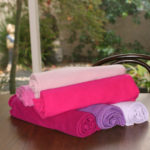Product information for:
Natural Pearls
Natural pearls are formed when a foreign particle enters the shell of a mollusc. Its presence irritates the inner surface of the shell of the mollusc which then produces calcium carbonate & conchiolin (nacre) to cover the foreign particle & reduce the irritation. The gradual secretion and cementing of the calcium carbonate on the foreign object results in the formation of the pearl. Natural pearls can take any shape and perfect round shapes are seldom seen.
Cultured Pearls
Cultured pearls are formed by cultivating the oysters and placing the foreign particle (a bead) in the shell of the molluscs. Several layers of calcium carbonate & conchiolin (nacre) gradually cover the bead, forming the pearl which takes on the shape of the bead.
The quality of the pearl is judged by its lustre, shape & size. The highest grade pearls have minimal flaws or spots in the nacre.
Freshwater Pearls
Freshwater pearls are typically found in rivers, lakes & ponds in China or Japan & are produced in mollusks called mussels. The irritant (bead) that is used to cultivate the pearls is normally small and 20 or more pearls may be produced by one mollusc. The pearls may take from 6 months to 2 years to form. Freshwater pearls are generally more irregular in shape and are more durable than salt water pearls.
Freshwater pearls typically range in size from 5mm to 12mm. 7mm to 9mm are the most popular sizes for necklaces while above 10mm is more rare and valuable. Typically the larger the freshwater pearl the more difficult it is to find a round, lustrous pearl.
Sea water Pearls
Only one pearl is produced per oyster and it may take more than 2 years for the pearl to form. The shape of pearl formed in saltwater oysters are almost round and rarely irregular. Saltwater pearls are more expensive than freshwater pearls because their cultivation is costlier.
Spanish Pearls
Spanish Pearls are hand made on the Island of Mallorca with a special opalescent glass. Shaped by an artisan the glass is coated a number of times with a special enamel imitating natures process of the pearl oyster. Giving it its characteristic colour & luminosity.
Mother of Pearl
Mother of Pearl is not a pearl but does have similarities. It is a natural shell material made up of thin layers inside shells called nacre which is obtained from the various types of shell mollusks such as oyster shells.
The Mother of Pearl is used to make various shapes including round beads that are frequently used in jewellery design. Being a natural material it may have unusual texturing or slight imperfections in the surface that can add to the character of the piece.
Natural Mother of Pearl is a mix of white, off white, cream & even a little beige in colour. It may also be dyed to obtain fashionable colours or bleached to obtain a uniform white.
925 sterling silver consists of 92.5 percent pure silver and 7.5 percent other metals, typically copper. The copper component is used to strengthen the Silver, making it suitable for use in jewellery.
Cashmere
 Cashmere is a luxurious natural fibre renown for its durability, silky softness, warmth and light weight.
Cashmere is a luxurious natural fibre renown for its durability, silky softness, warmth and light weight.
Cashmere comes from the soft undercoat of the Kashmir goat. Usually the finest cashmere is derived from the back and shoulders of the goat because these fibres are longer than those from the belly and hind area. The finest wool is normally produced in areas where the winters are cold and harsh.
